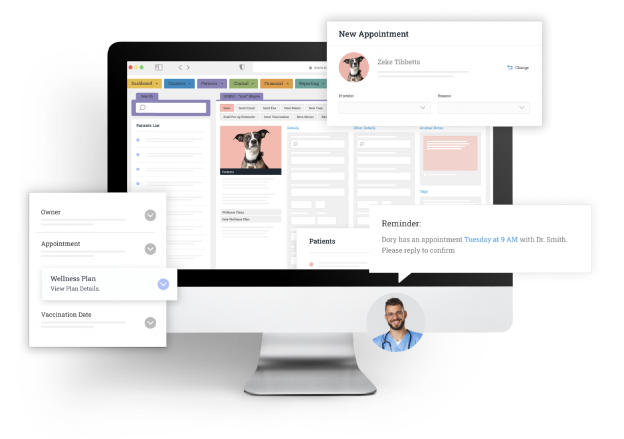Reducing Software Friction for Effective Client Communication

Digital communication tools and applications have revolutionized veterinary workflows and veterinary team interactions with clients. However, the tools that should make life easier can sometimes backfire if they don’t play nicely with existing practice management software. Constantly toggling between programs and windows can be time-consuming and redundant and lead to errors.
Software friction can saddle teams with manual tasks that take them away from patient and client care. However, modern veterinary software systems aim to eliminate this problem by integrating popular programs directly into the PIMS interface. Here’s what software friction could cost your team and how cloud-based software systems can help.
The cost of software friction
Everyday examples of software friction include having to copy and paste client or pet information from one system to another, enter notes about communications, and manually transfer confirmations from an external communication platform to the scheduler. The extra work causes delays and errors that impact the client experience and the veterinary team workflow. Software inefficiencies can be frustrating and may ultimately impact clinic operations and revenue.
Using integrated software solutions
Integrated software solutions reduce friction by allowing third-party programs and applications to communicate seamlessly with cloud-based PIMS. Full integration means the veterinary team can use the third-party app or feature in the standard PIMS interface, which greatly simplifies tasks and cuts back on tedious work. Instead of switching between appointment schedulers, billing systems, and client communication platforms, with integrated solutions, veterinary teams can manage every task from one centralized dashboard.
Traditional server-based PIMS may support limited integrations for basics like imaging and laboratory results, but a modern cloud-based system offers the most flexibility. The system continuously performs updates and improvements, so teams can use new integrations as they become available or request them from their software provider.
Here are some ways integrated solutions can make a difference:
- Centralized information — Quick, centralized access to client and pet information, medical records, and communication logs allows team members to help clients more effectively.
- Streamlined scheduling and reminders — Built-in scheduling tools help automate the scheduling and reminders process and allow clients to book online. Teams spend less time calling clients or retrieving confirmation from other platforms and more time interacting personally with clients.
- Easy billing and payments — Integrated billing can eliminate errors and toggling for credit card payments, third-party payors, and insurance companies. Plus, modern software systems can invoice via text or email and clients can pay online.
- Complete inventory solutions — Augment your system’s inventory management tools with integrations that help track usage, manage controlled drugs, and automatically adjust reorder levels.
- Accessible diagnostic results — Imaging and laboratory integrations allow veterinary teams to view, analyze, and manipulate diagnostic results in their management software rather than a separate workstation.
- Efficient record-keeping — Integrated dictation programs used during pet veterinary visits can automatically populate medical records, which eliminates the information transfer from an outside dictation service.
Improving communication with integration
Veterinary team members juggling—and often troubleshooting—multiple systems and technology platforms spend less time with clients and pets. Taking repetitive or complicated tasks off their plates creates a more client-focused, positive hospital culture that provides a better experience for clients, better care for pets, and a better work environment for employees.
Adopting inclusive software can make client communication seamless and effortless for team members. Modern practice management software can also automate communications, helping ensure consistency and continued pet owner engagement in their pets’ care plans.
Transitioning to modern veterinary practice management software with integration capabilities alleviates software friction. The entire veterinary team will benefit from fewer errors, smoother workflows, and more efficient operations and the positive, client-centric hospital culture they build.




